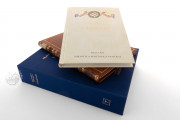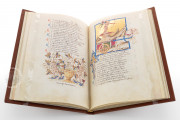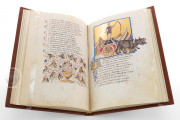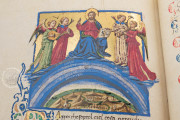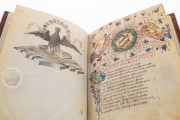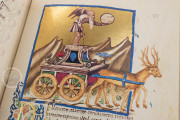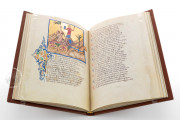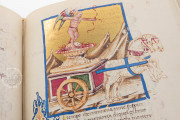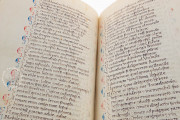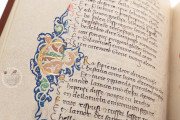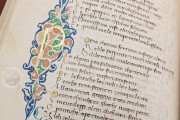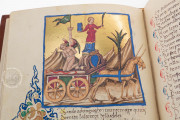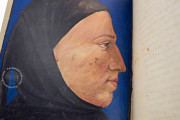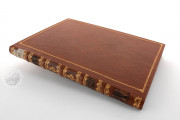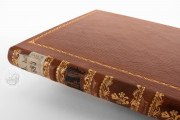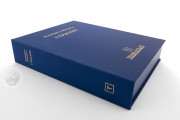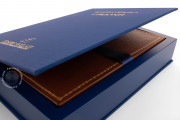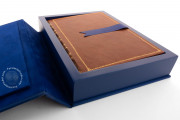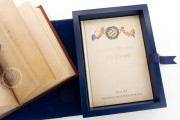The Vatican Urb. lat. 683 Petrarch is an illuminated manuscript of Petrarch's Trionfi ("Triumphs"), an Italian-language moralizing poem concerning the triumphs of allegorical figures. The manuscript was copied and illuminated in Florence in the 1440s and—by 1460—was acquired by the humanist bibliophile Federico da Montefeltro (1422-1482), Duke of Urbino. It is the collaborative work of the scribe Bese di Giovanni Ardinghelli and the illuminator Apollonio di Giovanni. Each of the poem's six triumphs is pictured in a half-page miniature.
In the Triumphs, Francesco Petrarch (1304-1374) describes in terza rima the successive triumphal processions of abstract concepts. Each defeats the preceding in the order of Love, Chastity, Death, Fame, Time, and Eternity (or Divinity). It was the most copied and illuminated of Petrarch's works in fifteenth-century Italy.
Iconic Triumphs
Apollonio focuses the first five triumph miniatures on the chariot and the triumphant allegorical figure silhouetted against a gold ground. Love, Chastity, Death, and Time proceed to the right, with the animals drawing the chariot—horses, unicorns, bulls, stags—transgressing the painted frame at the right (fols. 11r, 19v, 23r, and 33r).
Fame's triumph, by contrast, is portrayed as the personification of Glory (labeled GROLIA [sic] MUNDI, "earthly glory") seated frontally in a chariot led toward the viewer (fol. 26r). The triumph of Eternity is represented as the enthroned Christ flanked by angels, his right hand raised in a gesture of blessing (fol. 35v).
Portraits of Heroes of Italian Poetry
Separating the Triumphs from two short poems at the end of the manuscript are full-page profile portraits of Dante Alighieri (1265-1321), who invented the terza rima verse form, and Petrarch. Apollonio based Dante's physiognomy, specifically the long nose and serious countenance, on contemporary descriptions (fol. 38v). Petrarch is depicted in a black cowl, reflecting his position in the minor clerical orders in the Catholic Church (fol. 39v).
A Lasting Collaboration
The Vatican Urb. lat. 683 Petrarch's illuminator and chief scribe spent their careers in Florence and collaborated on other projects. One of the most ambitious is the Strozzi Petrarch, another splendid manuscript of the Triumphs.
A Text with a Complicated History
Petrarch revised the Triumphs over decades, and the text and its order are inconsistent among the many manuscript witnesses. Although the pictured triumphs appear in the correct order in the Vatican codex, the text begins with the second section of the Triumph of Death and proceeds to portions of Fame, Love, Chastity, Death, Fame, Time, and Eternity.
Elegant Presentation
Ardinghelli wrote the Triumphs in Mercantesca script, with the first majuscule letter of each line offset into the left margin (fols. 2-37). Paraphs—here alternating red and blue symbols shaped like a shaded majuscule G—mark the beginnings of each tercet. A second scribe penned the short poems at the volume's end (fols. 40-41).
The Triumphs opens with a headpiece featuring a pair of putti (naked winged youths) holding a wreath. A decorative tailpiece has been supplied where a section of the poem ends in the middle of a page. Thirteen white vine-stem initials articulate the text's divisions.
Federico da Montefeltro, Soldier and Bibliophile
Federico acquired the Vatican Urb. lat. 683 Petrarch early in his effort to build a great library, which included at least two more manuscripts of Petrarch's poetry (Vatican City, Biblioteca Apostolica Vaticana, MSS Urb. Lat. 331 and Urb. Lat. 370). The library of the dukes of Urbino entered the Vatican in 1657. The binding of red morocco over pasteboard dates from the seventeenth century.
We have 1 facsimile edition of the manuscript "Vatican Urb. lat. 683 Petrarch": Francesco Petrarca. I Trionfi facsimile edition, published by Istituto dell'Enciclopedia Italiana - Treccani, 2018
Request Info / Price

